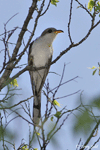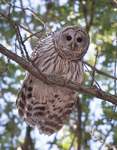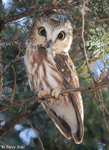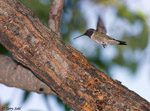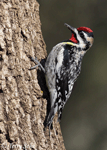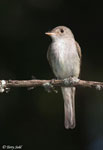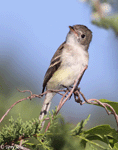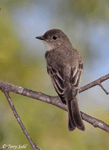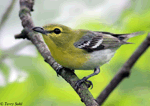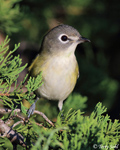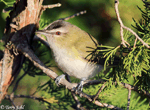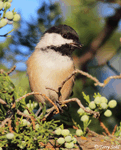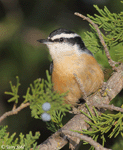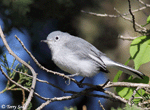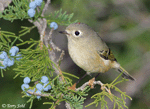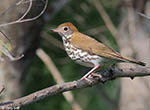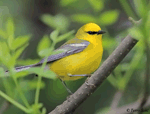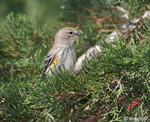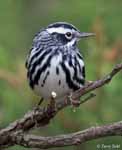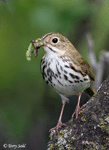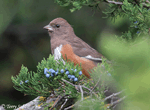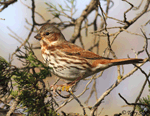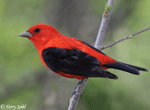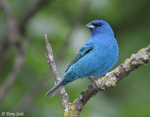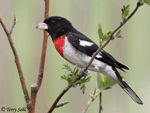South Dakota Birding Hotspot
Newton Hills State Park
Lincoln County
Directions:
| Click on points to view actual ground photos and birding information for those locations. Use the Google tools to switch between road maps, terrain, or satellite images. |
Newton Hills State Park is approximately 6 miles south of Canton, the county seat of Lincoln County. Newton Hills is easy to find. From the city of Canton, you simply take highway 135 south out of town. Highway 135 will take a jog to the east right after leaving Canton, and another 1 mile jog to the east about 3 miles south of town. After turning back towards the south, the road will wind down towards the river bottom, and the Big Sioux River will be visible on the east as forest encloses both sides of the road.
There are two entrances to the main portion of Newton Hills State Park. The first is 6 miles south of Canton, when Highway 135 reaches a low point near the river. This entrance, on the west side of Highway 135, leads to a small parking lot, as well as to camping spots next to "Sergeant Creek".
Another entrance is found 1 mile further to the south, also on the west side of the road. This is the primary entrance to the park, with an entrance booth at the entrance where you can pay the state park entrance fee. Several short roads can be found through this entrance, as well as more camping spots.
One more entrance is found half a mile to the south and half a mile to the east of the main entrance. This southern unit contains Lake Lakota.
Geographic Coordinates: 43° 13' 8" N, 96° 34' 10" W (coordinate of main entrance to park).
Description:
Newton Hills State Park is an oasis amongst the surrounding prairie and farmland, where flat agricultural land gives way to lush, thick deciduous forest amongst rolling hills. This dense deciduous forest sits on the Prairie Coteau, a hilly region created by glacial activity in the area thousands of years ago. The Big Sioux River flows just to the east of the park, and has associated bottomland forest, but Newton Hills itself is primarily characterized by upland deciduous forest on rolling hills.
The park is divided into two units. The northern unit (see map below) is heavily forested over much of its area. The upland forest consists of many large trees and shaded forest undergrowth covering rolling hills. Sergeant Creek runs along the northern edge of the park, near the "Horse Camp" and popular camping sites, and has different, bottomland forest species, including many large cottonwoods (some live, some dead). The Sergeant Creek area does indeed have a very small flow of water leading to the Big Sioux River to the east, but multiple beaver dams cross the creek near Highway 135, resulting in quiet and largely hidden small ponds in the ravine adjacent to the Horse Camp area. The water, thick undergrowth and brush, and large trees make the Sergeant Creek area one of the best birding spots in the state, with the opportunity to see forest species that are otherwise rare in South Dakota. Adjacent to Sergeant Creek is thick brushy undergrowth, transitioning to thick stands of sumac a bit further from the creek. Yet further from the creek, the sumac gives way to a large grassy expanse, which itself eventually gives way to a juniper-covered ridge marking the northern boundary of the park. Further south in the northern unit lies the main entrance to the park, with significant space devoted to campsites. From the main entrance, most roads lead to the campsites, but one wonderful loop road leads to the north and through the heart of the thick deciduous forest.
Several well-maintained trails are found in the northern unit of the park. Note that for some of the trails, you may have to share space with horses and occasionally mountain bikes. Many wonderful trails can be found leading from the Horse Camp area, while the extremely popular "Woodland Trail" is found around the central part of the northern unit.
The southern unit covers the northern part of Lake Lakota, a small reservoir popular with fishermen The southern unit lacks the thick deciduous forest of the northern unit, instead being covered by large areas of juniper and pine trees interspersed with open grassland areas. A small sandy beach is found on the northern edge of Lake Lakota, and picnic shelters are also found in this area.
Points of Note (Click on the points on the satellite map to see photos of the locations):
The Sergeant Creek area (point 1 on the image map to the right), found right at the first entrance to the northern unit (the "Horse Camp" area) is likely one of most popular locations to bird in the entire state. The water in the creek and associated beaver ponds, the brush and undergrowth along the creek, the large dead cottonwoods, the thick stands of sumac, and the deciduous forest species attract a wide variety of bird species along this short stretch, from woodpeckers to warblers, sparrows to hummingbirds, and even to Green Herons and Belted Kingfishers.
A bit further away from northern and western side of Sergeant creek lies a very large open space (point 2), bordered by thick sumac on the southern and eastern side, and by thick juniper stands on the ridge bordering the northern edge of the park. This open grassland, adjacent to the large area of deciduous forest in the park, is magical in the the early spring as night settles in, when American Woodcocks are seemingly sprouting up from the ground and spiraling up in the sky with their spectacular courtship displays.
Further up Sergeant Creek, the water disappears and the ravine narrows. The large grassland areas gives way to the dense deciduous forest marking much of the park. Point 3, the location where grassland and sumac give way to deciduous forest, is one of the best spots for finding spring warblers, including some fairly regular breeders that are otherwise quite rare in South Dakota.
Probably the most popular trail in the park with the public is the Woodland Trail, a lovely trail going through unbroken deciduous forest in the heart of the park (point 5). Birding tends to be less spectacular in the heart of the park than on the habitat edges mentioned previously, but true forest-loving species can be found here.
Especially on weekends during the summer, some of the best birding locations, such as along Sergeant Creek, can be a little crowded (well, crowded for South Dakota). One place I've had good luck birding that tends to be very quiet is point 4, along the western edge of the park. A hike along the trails to the west leads up a good-sized hill, and eventually to an open grassy and brushy area along the boundary of the park. It's further removed from the water along the creek, but as a mixed/edge habitat area, it also can often attract good variety and numbers of birds.
Birds of Note:
Newton Hills State Park offers the opportunity to see bird species you're simply unlikely to find elsewhere in South Dakota. Spring in Newton Hills can be truly spectacular for a birder, especially as warblers and other migrants move through in May. The area around Sergeant Creek often offers such South Dakota breeding rarities as Blue-winged Warbler, while other warbler species can be downright abundant as they migrate through the area. A male Prairie Warbler was found here in 2008, apparently attempting to breed with the often abundant Yellow Warblers along the creek. American Redstarts breed here, as do Eastern Towhees (and less often seen, Spotted Towhees). In recent years, nesting Barred Owls have been found near the creek, another true rarity in the state. Yellow-bellied Sapsuckers and Red-headed Woodpeckers are common here, with the Sapsuckers annually tapping into a few semi-famous "sapsucker trees" along the creek, creating sap wells which attract a host of other species, including Ruby-throated Hummingbirds. The area along the creek can also be thick with many sparrow species during migration, while Field Sparrows can seemingly be found in every patch of sumac throughout the summer and fall. Both Baltimore and Orchard Orioles are found in the edge habitat along the creek.
As you move closer to the edge of the thick deciduous forest, Indigo Buntings can be quite common, as can Scarlet Tanagers, making a wonderful splash of color among the green forest canopy. One of my favorite sounds in the spring...singing Ovenbirds in Newton Hills, with birds sometimes calling from all directions. Eastern Wood-pewees, Eastern Phoebes, Great-crested Flycatchers, and both Yellow-billed and Black-billed Cuckoos are often found or heard as you move up towards Sergeant Creek towards the picnic shelter. This area is also where I've had the best luck finding Blue-gray Gnatcatchers and Yellow-throated Vireos during the summer.
The denser deciduous forest areas have sometimes held breeding Kentucky Warblers, as well as a good variety of woodpeckers (Red-bellied, Downy, Hairy, and the aforementioned Yellow-bellied Sapsuckers). Wild Turkeys can be found here, as well as elsewhere in the park. Rose-breasted Grosbeaks offer a splash of color in the heart of the forest. Cooper's Hawks breed here, Broad-winged Hawks can occasionally be found, and Northern Goshawks can be found here in the winter.
The vast number of juniper trees found along the ridge on the northern edge of the park can be full of birds late in migration when the weather turns cold, and during the winter. While Cedar Waxwings are often described as unpredictable and erratic, this is one location where you can nearly always find some of the species. Ruby-crowned Kinglets and Yellow-rumped Warblers are very common in the junipers in the fall.
The beaver ponds along Sergeant creek can be very interesting for water birds. Wood Ducks are usually found there, Green Herons are sometimes common as well, and Virginia Rail have occasionally been found here. Moving water or perhaps a spring sometimes keeps small pockets of open water available even in the heart of winter, leading to my discovery of a Belted Kingfisher above the ponds on one bitterly cold January day.
Other Birding Locations (sorted by distance):
- Good Earth State Park (~25 miles)
- Big Sioux Recreation Area (~30 miles)
- Outdoor Campus in Sioux Falls (~30 miles)
- Beaver Creek Nature Area (~30 miles)
- Dewey Gevik / Wall Lake (~45 miles)
- Western Minnehaha County (~50 miles)
- North Alabama Bend (~50 miles)
- Gavin's Point Dam (~70 miles)
- Madison Waterfowl Production Area (~80 miles)
- Dakota Nature Park (~85 miles)
- Lake Thompson Area (~110 miles)
- Presho Area (~210 miles)
- Fort Pierre National Grasslands (~220 miles)
- Pierre / Oahe Dam Area (~255 miles)
- LaCreek National Wildlife Refuge (~280 miles)
